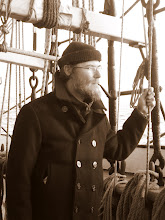The Nautilus Design
I recently found a PDF document of an analysis of Jules Verne's iconic submarine the Nautilus.
In a previous post, A School of Nautili, I linked to a catalog of designs based on Verne's descriptions in 20,000 Leagues Under the Sea.
This analysis by Stuart K Wier entitled simply "The Design of Jules Verne’s Submarine Nautilus" examines not only the details of the design but also some ideas of why Verne designed the Nautilus as he did and what some potential influences and inspirations he may have had.
Examining the original illustrations done for Verne's book is fascinating, since the illustrators were friends and acquaintances of Verne they had discussed the details with him before creating the illustrations. The paper includes many of these images which show the interiors of the Nautilus in all her glory.
I highly recommend this paper for anyone interested in the details of the Nautilus.
There are some snippets of the paper below to give you a taste of the style of this excellent paper.
Enjoy
Keep your sightglass full, your firebox trimmed and your water iced.
KJ
IntroductionWier's analysis of the propulsion system is interesting
In 1867 when Jules Verne was beginning to plan a novel about an undersea voyage, he and his brother Paul traveled to the United States on board the Great Eastern. The Great Eastern was an enormous vessel for its time, 213 meters (698feet) long, and 23 meters (75 feet) wide, in fact the largest vessel afloat, and it incorporated some of the newest features of marine architecture. It had a double iron hull, sails, steam engines, paddle wheels, and a propeller 7.3 meters (24 feet) in diameter. Verne showed and described his keen interest in the ship, and noted details of its design, construction, and operation. Thinking of an advanced undersea vessel, he found himself living on the the most advanced ship of his time. In the United States Verne saw other new technology, such as the large and fast Hudson River steamboats. This was a period of delight in rapid technical progress.
For the past century the submarine has played an important role in naval affairs, and more recently submersibles have become valuable in exploration of the oceans. Yet a fictional submarine, conceived decades before real submarines took up seagoing duties, remains a candidate for the most renowned: Jules Verne's Nautilus, from his novel Twenty Thousand Leagues Under the Sea.
Jules Verne is rightly regarded as a prophet of many of the inventions which characterized twentieth century life. The novels of Jules Verne are as well known for their technical innovations as for their plots of journeys to exotic locations. The submarine Nautilus and its enigmatic captain Nemo are among Verne's most famous creations. Even some who have not read Verne know that the Nautilus foreshadowed large modern submarines.
“The dynamic power of my engines is nearly infinite”:
Power, Propulsion, and Control
Despite a popular notion that Verne's Nautilus had some sort of futuristic power supply, such as atomic power, Verne based his technology on what was known in his day. The power supply is chemical batteries. Verne realized that the actual batteries of his day were far from adequate, as batteries remain today, but suggested they might be greatly improved. Nemo says he uses “large and powerful” Bunsen batteries rather than Ruhmkorff batteries which are less powerful. Nemo has improved the Bunsen battery by using elements of a sodium zinc amalgam in place of zinc alone, which Nemo claims doubles the “electromotive force” of the batteries (what we call today the voltage). Perhaps Verne was unaware of the explosive property of sodium in contact with water.
Nemo extracts sodium from sea water on a remote island, where the process is fueled with sea coal. The new sodium would recharge Verne's hypothetical batteries, which seem to last for months between charges.
The electricity, generated in the forward part of the engine room, powers large electromagnets which set in motion a system of levers and gears which transmits movement to the propeller shaft. In Verne's day development
of both batteries and electrical motors was primitive. Not until late in the 19th century did design of rotary electrical motors achieve their present level of high efficiency, due to the efforts of mathematically trained engineers such as Charles Steinmetz of General Electric. Verne seems to have in mind a reciprocating engine, something like a classic steamship engine with vertical steam cylinders, where electromagnets fill the role of the
cylinders. At that time, such a design seemed perfectly plausible. As it turned out, rotary electrical motors are much better.
The propeller has four blades, a diameter of 6 meters (19.7 feet), two meters less than the full diameter of the hull, and a pitch of 7.5 meters (24.6 feet). The propeller in the diagram shown below is that of the Great Eastern. That propeller presumably represents good design practice at the time Verne wrote. The Great Eastern's propeller weighed 36 tons; reduced to 6 meters diameter it would weight 20 tons. The text of the novel says the propeller can make 120 “turns per second,” which must be a typing mistake. That high figure is essentially impossible; even if you had the power to turn such an enormous propeller that fast, the result would be cavitation, frothing the water into steam bubbles, and little forward motion. Verne surely meant 120 turns per minute, still three times the rotation rate of the Great Eastern's propeller. At this rate the propeller would give a speed of, I estimate, 22 to 33 miles per hour, or 19 to 29 knots, a plausible speed for a high powered submerged submarine. There are some wholly unworkable characteristics of Verne's Nautilus, but the propeller is about right.



~ 0 comments: ~
~ Post a Comment ~